Physical Address
304 North Cardinal St.
Dorchester Center, MA 02124
The quotation above (Latin for “the dead teach the living”) historically has been cited either literally, as justification for examination of cadavers to learn anatomy and investigate pathology, or figuratively, to indicate learning from the work of past scholars. This chapter will present the history and past contributions of postmortem examination and will discuss the current objectives of autopsies, focusing especially on nonforensic autopsies.
The history of the autopsy is intimately connected with that of anatomy and medicine in general. According to the Egyptian historian Manetho, the king-physician Athotis (about 4000 bce ) wrote books on medicine, the first of which contained some anatomic descriptions. However, most scholars believe that early anatomic descriptions came primarily from the observations of animal anatomy made by early hunters, butchers, and cooks. King and Meehan, in their discourse on the origins of the autopsy, trace human knowledge of anatomy to the practice of haruspicy—the inspection of animal entrails, particularly the liver, to predict the future. This form of divination was widespread in the ancient world, performed at least as early as the fourth century bce in Babylonia. Later, the ancient Hebrews contributed more practical observations. Following the Talmudic law “Thou shalt not eat anything that dyeth of itself,” rabbis examined slaughtered animals for evidence of disease, especially in the lungs, meninges, and pericardium.
Anatomic study of human disease evolved slowly, however. In ancient Egypt, there was considerable interest in the relationship of wounds and fractures to anatomy but little concern with the effects of nontraumatic disease. The embalmers of ancient Egypt removed the internal organs through small incisions, but their observations were neither recorded nor related to diseases. Egyptian records dating from the seventeenth century bce (Edwin Smith Papyrus) and sixteenth century bce (Papyrus Ebers) dealt with surgical and medical diseases but related changes to magic rather than pathologic anatomy. Similar beliefs were held by the Assyrians and Babylonians. In ancient India, Susruta (circa 600 bce ) advocated human dissections, but despite relatively sophisticated contemporary surgical techniques, anatomic studies (with the exception of osteology) were rather limited. Practice of medicine in China and Japan was generally based on philosophy and religion rather than science, though during the Warring States Period (457-421 bce ) and in ancient texts there are references to examination of injuries. However, dissection was forbidden, and anatomic knowledge remained largely speculative, based on rare dissected bodies. The first recorded anatomic dissection of a human body in China occurred in 16 CE. The first known dissection in Japan was in 456 CE when an autopsy done on the body of Princess Takukete following her suicide revealed fluid in the abdomen with a “stone.”
The humoral theories of disease that dominated ancient Greek medicine provided an atmosphere that discouraged investigation to correlate anatomy with disease. The Hippocratic physicians described external manifestations of disease—infections, abscesses, and ulcerating and even infiltrating cancers—but were content to observe human anatomy only through wounds. It is likely that no human dissections were performed in Greece until the third century bce . Nevertheless, Aristotle (384-322 bce ) inspired the study of animal anatomy and development. Aristotle's sphere of influence expanded following the battlefield success of his pupil, Alexander the Great. Alexander's able comrade Ptolemy of Macedonia (367-282 bce ), who became Ptolemy I Soter, king of Egypt, created the environment in which pathologic anatomy first flourished. Ptolemy established the great university and library in Alexandria at the mouth of the Nile river. For four centuries, Alexandria attracted the best students of medicine. Here, scholars dissected the human body at least throughout the third century bce , aided by Ptolemy's policy of making the bodies of executed criminals available.
According to Pliny, Herophilos (335-280 bce ) was the first who “searched into the cause of disease.” He performed dissections of humans and wrote a treatise on human anatomy. It was his contemporary Erasistratus (circa 310-250 bce ), however, who broke from the humoral theories popular at the time and associated disease with changes in the organs. He believed in two circulations, one that carried the nutritive substance “parenchyma” (blood) from the heart to the organs through the veins and one that carried air from the lungs through the arteries. Failure of an organ to digest the nutrient substance caused plethora, or overfilling of the organ. Thus, he explained inflammation as overfilling of the veins with blood and fever as overfilling of the arteries with air. However, he correctly correlated excessive accumulation of fluid within the abdominal cavity with hardness of the liver. Although the great library of Alexandria was destroyed by the army of Julius Caesar in 48 bce , copies of some of the manuscripts had already made their way to Rome. Celsus (circa 30 bce -38 ce ), a Roman patrician and not a physician, compiled much of the medical knowledge in his eight-volume De re medicina . Here are described the cardinal symptoms of inflammation (“rubor, tumor, dolor, calor, et functio laesa”), splenomegaly in what presumably were cases of malaria, and inflammation of the cecum in what later was understood as appendicitis, along with descriptions of clinical findings in what were certainly cases of rabies, meningitis, gout, hernia, gonorrhea, scrofula, and urinary calculi.
The impressive compilation of Celsus was not influential on the physicians of the period, however, for it was unread and soon lost. Its impact came only in the Renaissance after it was discovered among stored documents in the church of St. Ambrose in Milan by Thomas of Sarzan (later Pope Nicholas V). The physicians of Rome followed the teachings of Galen (129-201 ce ). Although Galen performed anatomic dissections on animals, including primates, and made many original observations, his theories on pathophysiology were worthless because they were based on the old humoral doctrine. Unfortunately, his influence persisted until the late Middle Ages. Even during this generally unproductive period, however, there were some advances. In the Byzantine world, the physicians Oribasius (325-403), Aetius (502-575), Alexander of Tralles (525-605), and Paul of Aegina (625-690) preserved the teachings of others, as well as their own, through their writings. During this era, physical diagnosis and its basis in pathologic anatomy became more firmly rooted, and according to Procopius, as early as 543 physicians opened dead bodies searching for the cause of a plague epidemic in Byzantium.
A small sect of Christians, probably of Semitic or Aramean descent, who eventually became known as the Nestorians, migrated from the Arabian peninsula into Syria. At Edessa in Syria, the Nestorian bishop Rabboula had founded a hospital and medical school in 372 ce . Instruction was grounded in Hippocratic and Galenic teachings, and the faculty was composed of Christian and Jewish physicians. Opposed to the “heresy” of the Nestorian church, Emperor Zeno ordered the school closed in 489. The faculty fled to the town of Juní Shápúr in South Persia—a safe haven because it was administered by a Nestorian bishop. Neo-Platonist exiles from Athens arrived in 529. Instruction was given in Syriac, Greek, and Persian. Scientific expeditions into India brought back the works of the great Indian doctors Susruta and Charaka (circa first century bce to circa first century ce ), whose teachings were added to the Talmudic-influenced Greek medicine practiced at Juní Shápúr.
Beginning in the seventh century, the Arabs pushed westward across Persia, Byzantine Asia Minor, Syria, Egypt, and northern Africa and into Spain until their advance was stopped at the Pyrenees at the battle of Poitiers by Charles Martel in 732. The Arabian armies spared Juní Shápúr from destruction, and its medical school soon became the center of medical teaching for the Islamic world until late in the ninth century, when Baghdad gained greater prominence. During the next 3 centuries, the most important works in medicine sprang from the Caliphate empire and included those of Arabic and Jewish physicians such as Rhazes (860-932), Avicenna (980-1037), and Avenzoar (1070-1162). However, the greatest advances were in pharmacology rather than pathology, for the Koran condemned dissection as mutilation of the dead.
In China, human dissections were performed occasionally during the Sung dynasty. In 1045 ce , over a 2-day period, dissections of the bodies of 56 members of a band of rebels were recorded in an atlas. Between 1102 and 1106, Li Yee Siung, a government official, assembled physicians and artists to dissect a criminal and record the anatomic findings. In 1247, there appeared a handbook, Xi yuan ji lu (Collected Cases of Injustice Rectified) , perhaps based on earlier works that may have originated as early as the sixth century. It described postmortem observations and dealt with forensic issues, such as poisoning, decomposition, wounds from various weapons, strangulation, fake wounds, and difficulties in determining causes of death when bodies are recovered in water or after fires.
During the Arabic period, science was practically nonexistent in the developing European cultures. The collision of the two cultures would change that, however. The Saracens, who arrived in Spain during the eighth century, intermittently raided and invaded Sicily and southern Italy and soon established colonies in the region. Jewish groups educated in Arabic thought also settled here. The town of Salerno on the Campanian coast, where a medical school had been founded as early as the ninth century, became the focal point. In 1076, the Normans took Salerno. At the same time, the monk-physician Constantine the African (?-1087), who had traveled for nearly 40 years through Mesopotamia, India, Ethiopia, and Egypt studying medicine, arrived at the Benedictine abbey of Monte Cassino near Salerno, where a hospital had been established as early as 539. Here, he and his pupils began translating medical works from Arabic into Latin. The significance of the works was quickly appreciated by the physicians at the Salerno school. The influence of the medical school grew, and it received official state sanction from Frederick II in 1231. Flourishing well into the thirteenth century, it attracted students widely, and its courses of instruction were adopted by the great universities that existed in Naples, Bologna, Padua, Montpellier, and Paris. At the University of Bologna, Taddeo di Alderotto (1206?-1295) apparently made dissections of the human body a regular part of university teaching, and his students, such as Mondino (1265-circa 1326) and Mondeville (circa 1250-1320), followed this example.
The first law authorizing human dissection (1231) is generally credited to Frederick II (1194-1250), Holy Roman Emperor. During the thirteenth and fourteenth centuries, restriction against opening the human body after death eased. According to Chiari, a physician of Cremona performed autopsies on victims of the plague of 1286. The Pope apparently authorized opening of bodies during the Black Death (1347-1350) to determine the cause of the disease. Autopsies were performed in Siena in 1348 and authorized at Montpellier ( Fig. 1-1 ) around 1376. However, initially bodies were more likely opened for legal rather than educational purposes. Records indicate that William of Saliceto (circa 1201-1280), a Bolognese surgeon, performed at least one medicolegal necropsy. Another early forensic autopsy was ordered by the court as part of the investigation of the death of Azzolino, an Italian nobleman who died suddenly in 1302, presumably from poisoning. Although the final judgment is unclear, the report describes an internal examination of the body.
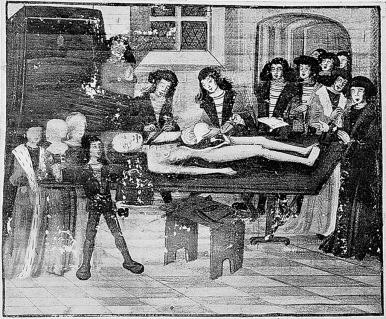
With the Renaissance, medicine and medical education were transformed. Public human dissections spread through the universities from Italy north across the Alps. Professors sitting in raised chairs supervised assistants, commonly barber-surgeons, in formal dissections that lasted for several days and were attended by as many as 100 onlookers. The long-held doctrines of Galen began to break down. Leonardo da Vinci (1452-1519) made drawings from some 30 human dissections. Antonio Benivieni (circa 1443-1502), a Florentine physician, requested permission from relatives to perform postmortem examinations in enigmatic cases ( Fig. 1-2 ). He kept careful case records, and these were published by his brother in 1507 as The Hidden Causes of Disease . Included in the 111 short chapters of this treatise are descriptions of 20 postmortem examinations. However, Benivieni only incised rather than dissected the bodies, and the findings reported are superficial.
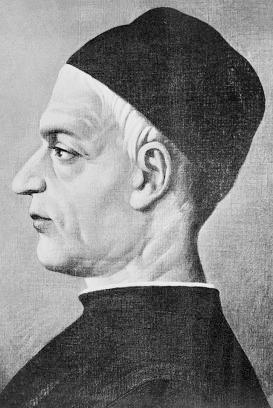
The first recorded autopsy in North America was an examination of conjoined twins performed in 1533 in Santo Domingo. Authorized by the clergy, its goal was not to establish cause of death but rather to determine whether there were two souls or one. The records of the second voyage (circa 1536) of Jacques Cartier up the St. Lawrence River described an internal examination of a sailor who died of a strange disease (scurvy), performed in the hope of identifying its cause and preventing its spread to other members of the crew. As early as 1576 in Mexico City, Francisco Hernandez and Alonzo Lopez performed limited postmortem examinations.
In the sixteenth century, Andreas Vesalius (1514-1564) from Brussels ushered in the modern era of studying anatomy. After completing his studies at Padua, he was appointed professor of surgery there and given the duty of conducting the public dissections. However, Vesalius did his own dissections, using his students as assistants. Vesalius' pupils spread throughout Europe, advancing the anatomic concept of disease as they began recognizing abnormal findings during anatomic dissections. In Germany, Johann Schenck von Grafenburg (1530-1598) performed postmortem examinations and recorded the findings as part of his practice as town physician for Freiburg and Strassbourg. In Germany and France, by the end of the sixteenth century, death investigations that included autopsies became more common and were bolstered by laws such as the Constitutio Criminalis Carolina enacted by Holy Roman Emperor Charles V (1500-1558), which sanctioned forensic autopsies, thereby encouraging the growth of legal medicine as an academic discipline. At the University of Paris, Jean Fernel (1497-1558) supplemented his studies of medicine, and particularly tuberculosis, with postmortem examinations. His chapter on pathology in his book Medicina (1554) was the first treatise to consider the pathogenesis of disease and contained the first clear description of what Reginald Fitz would later identify as appendicitis. Following an autopsy on a 7-year-old boy who died during the Paris diphtheria epidemic of 1576, Guillaume de Baillou (1538-1616) described the false membrane covering the airway that characterizes the disease. A London physician, George Thomson (1619-1677), remained in that city during the Great Plague of 1665 and attempted to determine its cause through postmortem examinations. In 1666 he published his studies in Loimotomia, or The Pest Anatomized, which included an engraving of an autopsy dissection of a plague victim as its frontispiece ( Fig. 1-3 ). In Italy, Fortunatas Fidelis (1551-1630) and the papal physician Paulo Zacchias (1584-1659) published De relationibus medicorum and Questiones medico-legales, respectively, influential textbooks of legal medicine. By the mid-seventeenth century formal lectures in forensic medicine were given in Germany by Johann Michaelis (1607-1667) and, thereafter, by Johannes Bohn (1640-1718), both of the University of Leipzig. Bohn published a book on wounds (De renunciatione vulnerum seu vulnerum lethalium examen) in 1689 and followed it with a more extensive treatise, De officio medici duplici clinici nimirum ac forensis, in 1704. A number of professorships in forensic medicine were established at the German universities during the seventeenth century, and professorial chairs in legal medicine were in place in France by 1794 and Great Britain (Edinburgh) by 1803. By this time, additional legal medicine books or collections of cases that included forensic methods for solving them were available. In 1804, James Stringham (1775-1817) of New York gave the first lecture on legal medicine in the United States. In 1813, Stringham became the first American professor of the discipline.
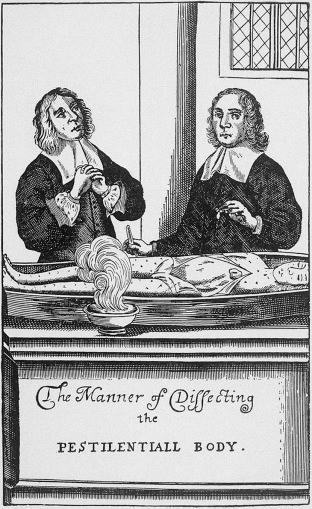
With William Harvey's (1578-1657) description of the circulation in 1628, the stage was set for the physiologic interpretations of pathologic findings. A pathologic anatomy museum was established by Riva (1627-1677). Marcello Malpighi (1628-1694), Francis Glisson (1597-1677), and Franciscus Sylvius (1614-1672) routinely performed autopsies. The findings of many of these autopsies were compiled by Theophile Bonet and published in 1769 as the Sepulchretum sive anatomica practica . However, he made no attempt to correlate pathologic findings with clinical symptoms except for occasional references to the humoral doctrine. In contrast, Giovanni Morgagni (1682-1771) was among the first to correlate clinical symptoms with organic changes ( Fig. 1-4 ). His autopsy reports, published in 1761 as De sedibus et causis morborum per anatomen indagatis (The Seats and Causes of Diseases Investigated by Anatomy), numbered more than 700 and included descriptions of coronary artery atherosclerosis, aneurysms, endocarditis, lobar pneumonia, hepatic cirrhosis, fatty liver, renal calculi, hydronephrosis related to ureteral stricture, and various cancers. Although Bonet's Sepulchretum is largely forgotten, Morgagni's work stands as one of the most influential in the history of medicine, for it convinced the physicians of its day that advancement of medicine rests in sound clinical-pathologic correlation.
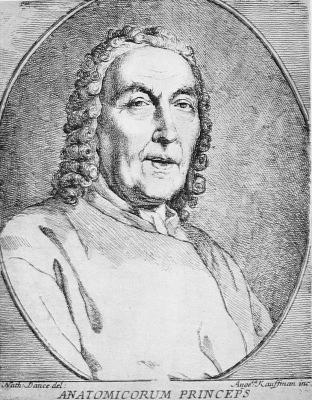
In France, Marie-François-Xavier Bichat (1771-1802) was perhaps the first experimental pathophysiologist and, along with his countrymen Jean-Nicolas Corvisart (1755-1821) and Réné-Théophile-Hyacinthe Laënnec (1781-1826), advocated the correlation of pathologic findings with physical diagnosis ( Fig. 1-5 ). Bichat's career, cut short by tuberculosis, was notable for another reason, however. By subjecting organs to heat, air, water, acids, alkalis, salts, and so forth, and without a microscope, he determined that organs were composed of tissues (from the French tissu, or cloth). He distinguished 21 kinds of tissues. Furthermore, he recognized that disease weakened tissues and that this effect of disease was the same no matter which organ was affected.
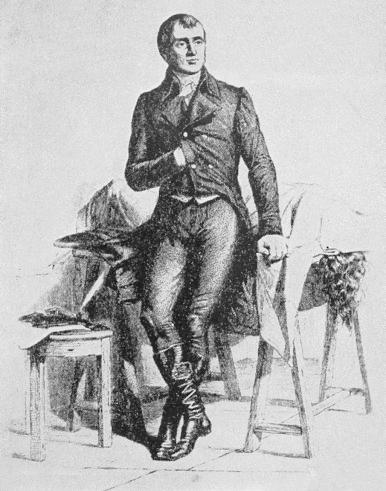
At roughly the same time, great strides were also made in Scotland and England. William Hunter (1718-1783) and John Hunter (1728-1793) established the first English museum for the teaching of pathology. Matthew Baillie (1761-1823) published the first atlas of pathology in 1793; he described situs inversus, hydrosalpinx, dermoid ovarian cysts, and “hepatization” of the lungs in pneumonia and further clarified cirrhosis of the liver ( Fig. 1-6 ). Postmortem examinations were a regular event at Guy's Hospital in London, performed by Sir Astley Cooper (1768-1841), Richard Bright (1789-1859), Thomas Addison (1793-1860), and Thomas Hodgkin (1798-1866), who used their findings to advance the field of medicine.
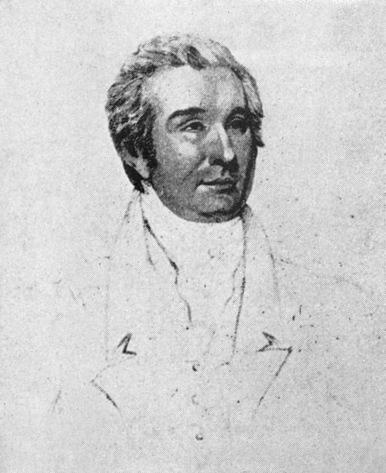
At the beginning of the nineteenth century, the wealth of information available from the autopsy was still largely untapped. Autopsies were usually confined to one organ, which was generally chosen by the clinician on the basis of medical judgment. Autopsies begun without a specific direction were often concluded when the prosector, usually an untrained surgical assistant, determined the seat of disease, leaving many organs unexamined or at best given a cursory evaluation.
While this state of affairs persisted in Paris, Edinburgh, and London, there were new developments in Vienna and Berlin. At the Allgemeines Krankenhaus at Vienna, Karl Rokitansky (1804-1878) performed more than 30,000 autopsies ( Fig. 1-7 ). Through the influence of the editions of his manual Handbook of Pathological Anatomy, the autopsy became an important and integral part of medicine during the first half of the nineteenth century. However, Rudolph Virchow (1821-1902), by applying microscopic examination to diseased tissues and recognizing cellular alterations, became known as the founder of modern pathology ( Fig. 1-8 ). To be sure, Virchow stood upon the shoulders of the early histologists, his mentor Johannes Müller (1801-1858) and two previous students of Müller, Theodor Schwann (1810-1882) and particularly Jacob Henle (1809-1885). Nevertheless, it was the publication in 1858 of 20 of Virchow's lectures in Cellular Pathology as Based upon Physiological and Pathological Histology that ushered in the modern age of pathology.
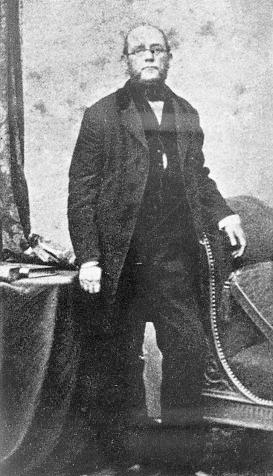
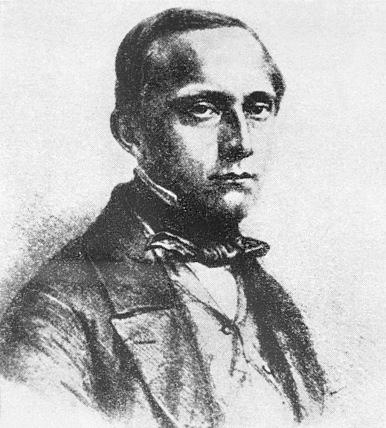
To Rokitansky and Virchow, we can trace systematic examination of organs. In 1876, Virchow published a book on autopsy technique in which he introduced a detailed postmortem technique designed to identify abnormalities in organs and retain important anatomic relationships when necessary for demonstrations. After examination of the organs and their relationships in situ, Virchow removed them one at a time. Following their removal, he performed further dissection outside the body. Moreover, he preserved regional organ relationships if indicated. This contrasts with the technique developed earlier by Rokitansky, as described by his student Chiari in a book first published in 1894. Rokitansky examined and opened all organs in situ, preserving all abnormal relationships. Friedrich Albert von Zenker (1825-1898) developed a technique similar to Rokitansky's in that it emphasized preservation of topographic anatomy, and two of his students, Heller and Hauser, each described their own versions in publications. In their modifications, physiologically related organs were removed together and connections were maintained unless the pathologic process could not be demonstrated. The first substantial American works on autopsy technique were published by Delafield in 1872 and Thomas in 1873. Joined by coauthor Prudden in 1885 and eventually revised by Wood, the Delafield work evolved into a complete textbook of pathology but continued to include a description of autopsy technique through numerous editions.
Books by Nauwerck, Woodhead, Hektoen, Clarke, Warthin, Cattell, Mallory, Box, Beattie, and Miller described modifications of or improvements on the autopsy technique of Virchow. Versions based on all of these are in practice today. In France, Maurice Letulle (1853-1929) described a technique based on en bloc removal of the thoracic and abdominal organs. With variations, it remains a popular alternative to the organ-by-organ approach that descended from Virchow. A four-volume work, Medical Jurisprudence, Forensic Medicine and Toxicology, edited by Witthaus and Becker with many contributors, was published in 1894 to 1896 and incorporated various burgeoning disciplines of forensic medicine and science.
The first half of the twentieth century saw, in addition to standardization of postmortem dissection procedures, improvements in tissue embedding, microtomy, and histochemistry. In North America, leaders of medicine, including Sir William Osler (1849-1919), stressed the importance of the autopsy in both undergraduate and postgraduate medical education ( Fig. 1-9 ). As a student at McGill University, Osler was actively involved with autopsies. For his graduation thesis, which consisted of reports of 50 postmortem examinations and included 33 specimens, he received a special prize from the faculty. Following postgraduate study at University College in London (1872-1873), Osler spent 3 months in Berlin under Virchow and 5 months in Vienna, primarily with Rokitansky. On his return to Montreal in 1874, Osler began a decade-long service at McGill University and its associated Montreal General Hospital, where he performed nearly 800 autopsies in addition to his clinical and teaching duties. These cases formed the basis for numerous presentations and case reports and ultimately became the foundation of his textbook, The Principles and Practice of Medicine (1892).
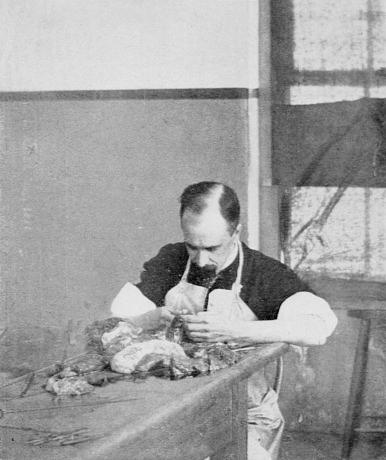
Flexner's report on medical education in Canada and the United States advocated the autopsy as an important tool for ensuring hospital quality, and accrediting agencies defined acceptable autopsy rates. In 1936 the newly formed American Board of Pathology began certifying pathologists. This raised the standards for the training of pathologists, and training largely revolved around the autopsy table. Forensic pathology burgeoned, becoming a subspecialty of pathology, and the medical examiner system began to replace the coroner system. In the United States, the hospital autopsy rate, which was about 12% in 1910, climbed to about 50% by the late 1940s with the overall rate compounded by the increasing percentage of deaths occurring in-hospital.
In an editorial that appeared in the Journal of the American Medical Association in 1956, Starr questioned the value of the “classical” autopsy. Although his premise generated a lively rebuttal, the fact remains that after a century, the autopsy was moving away from its place in the center of the medical stage. Autopsy rates started to decline in United States hospitals after 1955 ( Fig. 1-10 ). In 1971 the Joint Commission for the Accreditation of Hospitals (JCAH) dropped its recommendation for a 20% to 25% autopsy rate in accredited hospitals, in large part because of the difficulty community hospitals had in maintaining those rates. Although the numbers of hospital autopsies were decreasing before this change in policy, the JCAH decision lent tacit acceptance to this state of affairs. Rigorous objections to the decision appeared in print but failed to sway policy makers. In 1986, the Center for Medicare and Medicaid Services eliminated minimum autopsy requirements specified in its Conditions of Participation for Hospitals, instead specifying that “the medical staff should attempt to secure autopsies in all cases of unusual deaths and of medical-legal and educational interest.”
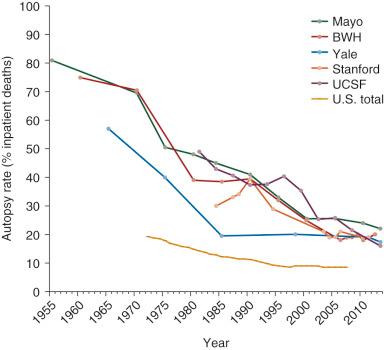
Why was there such a steady decline in autopsy rate? At the height of autopsy activity, new demands diverted pathologists' attentions. The role of clinical pathologists grew as physicians relied on increasing numbers of sophisticated laboratory tests. Surgeries and endoscopies increased surgical pathology specimen numbers and the demands on pathologists' time. The value of cytologic examinations in disease prevention and recognition led to their expanded use and consequently increased pathologists' workload. All of these endeavors provide direct remuneration for pathologists. In contrast, U.S. pathologists' compensation for autopsy practice generally remains hidden in the hospital budget and daily room rate, where it is essentially considered overhead. For the pathologist practicing in the community, the autopsy room became a place to avoid. At academic medical centers, pathology departments invested in experimental pathologists and busy surgical pathologists, not autopsy prosectors. Too frequently, the inexperienced house officer was poorly supervised during much of the autopsy, and the quality of autopsy findings suffered. A generation of pathologists was trained in an environment that devalued the autopsy.
The responsibility for the decline of the autopsy does not rest on the shoulders of pathologists alone. Clinical teams, who along with hospitals and health care organizations are prime consumers of the autopsy, have requested fewer. A number of reasons for this have been suggested, the following most frequently: (1) greater confidence in modern diagnostic techniques, (2) unwillingness to dwell on clinical outcomes perceived as failures, (3) fear that autopsy results will increase malpractice risks, (4) difficulty in obtaining autopsy authorization from the grieving family, and (5) dissatisfaction with the quality or timeliness of autopsy reports. The shift in care of patients from a general practitioner to multiple specialists and the concomitant lack of rapport among physician, patient, and family made it easier for relatives to refuse an autopsy request from a physician with whom they had no long-term relationship.
Families of the deceased have resisted autopsies for numerous reasons, including being poorly informed about the value of the autopsy, fear that they might be billed for the service, anxiety about delays in funeral arrangements, concern that the deceased had suffered enough, and religious convictions or cultural beliefs. Although funeral directors often believe in the value of autopsies, delays in receiving the remains, increased difficulties in embalming, and concern of the family about possible disfigurement of their relatives after autopsy have led morticians sometimes to counsel families against authorizing autopsies. Increasing numbers of patients with chronic diseases are dying outside the hospital—at home or in nursing homes or hospices—in sites where there is often less interest in postmortem examination.
Near the end of the twentieth century, the national autopsy rate in the United States, including forensic cases, fell below 10%, and to nearly 5% if deaths caused by accidents, homicide, and suicide are excluded. Alarmingly, many community hospitals perform few if any autopsies each year. Meanwhile, the autopsy rates at academic medical centers appear to have leveled off since 2001 to about 15% to 20% due to continuing interest in autopsies by families, clinical teams, and pathologists in this setting ( Fig. 1-10 ). Academic medical centers often work to maintain such autopsy rates by improving the handling of decedent affairs; information for families and clinical teams; and the relevance, quality, and timeliness of autopsy reports. As a consequence of the variability in interest, the autopsy rates for certain groups (e.g., elderly people) and diseases (e.g., cerebrovascular) are particularly low. From 1980 to 1984, the autopsy rate in New York state nursing homes was less than 1%, although 20% of all deaths in the state occurred in these institutions. In fact, this represents the current situation nationwide, in which old age and death in a nursing home both have a statistically negative relationship with whether an autopsy is performed. Similar data come from Australia, Denmark, Japan, Sweden, and the United Kingdom.
The nonforensic autopsy continues to be a key aspect of medicine today, with increasing relevance in modern trends, such as quality assurance/improvement, measurement of clinical outcomes, infection control, and personalized medicine. Personalized medicine has increased the level of interest in patients' possible hereditary conditions and in treatment responses and adverse events in the expanding number of clinical trials. While advances in radiology, biopsy techniques, and diagnostic tests have made major strides in providing accurate diagnoses in patients, they also often raise many smaller questions for autopsy. Autopsies now also provide more refined diagnosis by using advanced microbiological tests, molecular tests, and immunohistochemistry—all necessarily guided anatomically. The digital revolution has also made autopsy reporting more effective through timely reporting via electronic medical records and secure e-mails to clinical teams complete with high-quality images. Families of patients are now much more informed and active in decision making, frequently initiating requests for autopsies. Of note, a survey of Swedish citizens indicated that declining autopsy rates are apparently not a consequence of negative attitudes toward the procedure. In the United States, some entrepreneurs have found commercial success providing private autopsy services to a receptive public. Thus it seems the major challenge in preserving the autopsy rests not on convincing the public of the merits of autopsies but rather on reengaging the medical professions—including pathologists.
Of course, much of this will depend on finances and regulations in health care, which are always evolving. In the past, payments for autopsy in the United States have been made through Medicare Part A reimbursements to hospitals in ways that are not related to the number of autopsies done. The College of American Pathologists has strongly advocated for direct reimbursement for autopsy and has developed a consensus for the relative value unit workload values that should be assigned to complete autopsies ; however, this has not yet been instituted in reimbursement policies by insurers. While cost-containment efforts and capitation-based payment would likely exert additional restraints, there is interest by government organizations in using autopsy to track outcomes in accountable care organizations, but this would depend on future regulations.
Become a Clinical Tree membership for Full access and enjoy Unlimited articles
If you are a member. Log in here